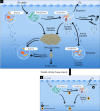Monitoring and modelling marine zooplankton in a changing climate
- PMID: 36732509
- PMCID: PMC9895051
- DOI: 10.1038/s41467-023-36241-5
Monitoring and modelling marine zooplankton in a changing climate
Abstract
Zooplankton are major consumers of phytoplankton primary production in marine ecosystems. As such, they represent a critical link for energy and matter transfer between phytoplankton and bacterioplankton to higher trophic levels and play an important role in global biogeochemical cycles. In this Review, we discuss key responses of zooplankton to ocean warming, including shifts in phenology, range, and body size, and assess the implications to the biological carbon pump and interactions with higher trophic levels. Our synthesis highlights key knowledge gaps and geographic gaps in monitoring coverage that need to be urgently addressed. We also discuss an integrated sampling approach that combines traditional and novel techniques to improve zooplankton observation for the benefit of monitoring zooplankton populations and modelling future scenarios under global changes.
© 2023. The Author(s).
Conflict of interest statement
The authors declare no competing interests.
Figures




Similar articles
-
Consistent trophic amplification of marine biomass declines under climate change.Glob Chang Biol. 2019 Jan;25(1):218-229. doi: 10.1111/gcb.14468. Epub 2018 Oct 30. Glob Chang Biol. 2019. PMID: 30295401
-
Gelatinous larvacean zooplankton can enhance trophic transfer and carbon sequestration.Trends Ecol Evol. 2023 Oct;38(10):980-993. doi: 10.1016/j.tree.2023.05.005. Epub 2023 Jun 3. Trends Ecol Evol. 2023. PMID: 37277269 Review.
-
Fish-mediated plankton responses to increased temperature in subtropical aquatic mesocosm ecosystems: Implications for lake management.Water Res. 2018 Nov 1;144:304-311. doi: 10.1016/j.watres.2018.07.055. Epub 2018 Jul 23. Water Res. 2018. PMID: 30071399
-
Biomass changes and trophic amplification of plankton in a warmer ocean.Glob Chang Biol. 2014 Jul;20(7):2124-39. doi: 10.1111/gcb.12562. Epub 2014 May 7. Glob Chang Biol. 2014. PMID: 24604761
-
The biogeography of marine plankton traits.Ecol Lett. 2013 Apr;16(4):522-34. doi: 10.1111/ele.12063. Epub 2013 Jan 30. Ecol Lett. 2013. PMID: 23360597 Review.
Cited by
-
Spatio-temporal variability of mesozooplankton distribution along the Canary Current Large Marine Ecosystem: a regional perspective.J Plankton Res. 2025 Jan 30;47(1):fbae079. doi: 10.1093/plankt/fbae079. eCollection 2025 Jan-Feb. J Plankton Res. 2025. PMID: 39886552 Free PMC article.
-
Graph neural networks and transfer entropy enhance forecasting of mesozooplankton community dynamics.Environ Sci Ecotechnol. 2024 Nov 26;23:100514. doi: 10.1016/j.ese.2024.100514. eCollection 2025 Jan. Environ Sci Ecotechnol. 2024. PMID: 39703568 Free PMC article.
-
Critical factors driving spatiotemporal variability in the phytoplankton community structure of the coral habitat in Dongshan Bay, China.Front Microbiol. 2024 Feb 16;15:1355028. doi: 10.3389/fmicb.2024.1355028. eCollection 2024. Front Microbiol. 2024. PMID: 38435699 Free PMC article.
-
More realistic plankton simulation models will improve projections of ocean ecosystem responses to global change.Nat Ecol Evol. 2025 Jul 1. doi: 10.1038/s41559-025-02788-3. Online ahead of print. Nat Ecol Evol. 2025. PMID: 40596728 Review.
-
Warming alters plankton body-size distributions in a large field experiment.Commun Biol. 2025 Feb 3;8(1):162. doi: 10.1038/s42003-024-07380-2. Commun Biol. 2025. PMID: 39900706 Free PMC article.
References
-
- Pitois SG, Lynam CP, Jansen T, Halliday N, Edwards M. Bottom-up effects of climate on fish populations: data from the Continuous Plankton Recorder. Mar. Ecol. Prog. Ser. 2012;456:169–186.
-
- Ruzicka JJ, et al. Interannual variability in the Northern California Current food web structure: changes in energy flow pathways and the role of forage fish, euphausiids, and jellyfish. Prog. Oceanogr. 2012;102:19–41.
-
- Lauria V, Attrill MJ, Brown A, Edwards M, Votier SC. Regional variation in the impact of climate change: evidence that bottom-up regulation from plankton to seabirds is weak in parts of the Northeast Atlantic. Mar. Ecol. Prog. Ser. 2013;488:11–22.
-
- Heneghan, R. F., Everett, J. D., Blanchard, J. L. & Richardson, A. J. Zooplankton are not fish: improving zooplankton realism in size-spectrum models mediates energy transfer in food webs. Front. Mar. Sci.10.3389/fmars.2016.00201 (2016).
-
- Lehette P, Tovar-Sánchez A, Duarte CM, Hernández-León S. Krill excretion and its effect on primary production. Mar. Ecol. Prog. Ser. 2012;459:29–38.
Publication types
MeSH terms
LinkOut - more resources
Full Text Sources
Research Materials

